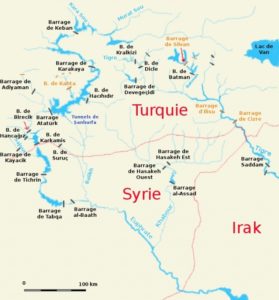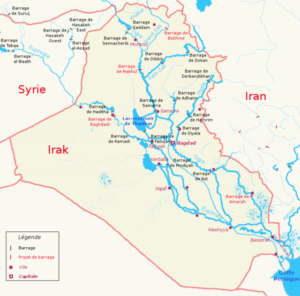
Strategist: Turkey pushes the Middle East to a new war
NOVEMBER 06, 2019 – INTERNATIONAL POLICY. ««STATEMENT On the implementation of the Arbitral Award of 28 President of the United States of America Woodrow Wilson of 22 November 1920-»»
annotation
Throughout the history of the Middle East, water has often acted as a weapon or trigger, leading to conflict. In the last 60 years alone, there have been at least 25 cases where water has caused conflict between different communities and between states.
In the future, Middle Eastern countries may face
reducing rainfall, surface and groundwater reserves, as well as strengthening the desertification process, writes Connor Dillin in an article for The Strategist.
Since 1998, the region has experienced the most severe droughts in 900 years. In the Middle East, 10 out of 17 countries of the world are located that are currently facing “extremely high” levels of water scarcity. A sharp increase in temperature throughout the region will accelerate the evaporation of surface waters. By 2050, average summer temperatures in the region are expected to rise by 4 ° C, even if global growth does not exceed 2 ° C.
Between 2003 and 2010, a number of territories in Turkey, Syria, Iraq and Iran, located along the Tigris and Euphrates basins, faced a decrease in the total fresh water supply by 144 cubic kilometers, while 60% of these losses were associated with the pumping of groundwater from underground reservoirs.
Given all of the above, it is serious concern that the construction of dams could exacerbate the negative impact of climatic conditions on water supply in the Middle East. Dam projects can only further complicate the already acute problem of water scarcity and land degradation, which would jeopardize agriculture throughout the region.
Turkey’s dam construction program in Southeast Anatolia is one of the largest and most controversial dam construction programs in the world. Ankara plans to create 22 dams along the Tigris and Euphrates rivers near the Turkish borders with Syria and Iraq. This project has angered the Middle Eastern countries from the very beginning because of its potential impact on water resources in countries south of Turkey. In the past few months, Ankara has filled the reservoirs of the Ilisu dam, which will be the largest in the proposed network of dams. Ankara’s actions added fuel to the already strained relations with neighboring countries.

Map showing the location of the constructed and planned dams on the Tigris within Turkey
X. Guimard
The construction of dams and hydropower plants in Turkey on the Tigris and Euphrates, according to various estimates, has led to a 80% reduction in water supplies in Iraq since 1975, threatening agriculture and the natural habitat. Iraq also suffered from agricultural development and the construction of dams in Iran. As a result of reduced water resources, desertification, soil salinization and poor management, Iraq currently loses about 25 thousand hectares of arable land annually, mainly in the south of the country.
Syria has also been directly affected by Turkish dam construction projects, which have reduced the flow of water into Syria by about 40%. Because of this, Damascus faced serious problems, since the issue of water shortages in Syria is more acute than in Turkey and Iraq. The long drought that began in 2006 destroyed Syrian agriculture and forced a large number of people to move to cities. All this also contributed to the social upheaval and unrest that led to the Syrian civil war. By 2011, the total annual water withdrawal in Syria as a percentage of domestic renewable water resources reached 160%, compared with 80% in Iraq and 20% in Turkey.
Iran also criticized the Turkish dam construction program, saying that the Ilisu dam poses “a serious environmental threat to Iraq and, ultimately, to Iran, as it will reduce the flow of Tigris into Iraqi territory by 56%.” Iran is facing a widespread water crisis: 12 out of 31 Iranian provinces are expected to run out of groundwater over the next 50 years. Tehran predicts a 20% reduction in surface water runoff from precipitation and snowmelt by 25%. Against this background, the waters of the Tigris begin to play an even more important role in terms of the functioning of Iran’s agriculture.
Obviously, the Middle East is facing a wide range of climatic and environmental problems, which together pose potentially existential problems for the countries of the region. The most important issue is water security, and the Tigris-Euphrates transboundary river system is its key component. As for Turkey, it has some advantages: it controls 90% and 44% of the Euphrates and Tigris watercourses, respectively. Moreover, over the past 20 years, Ankara has ignored the demands of its neighbors in the framework of a formal agreement on the joint use of water, which involves the regulation of flows within the Tiger-Euphrates river system.

Map showing the location of the constructed and planned dams on the Tigris within Iraq
Guimard
Against the backdrop of regional instability and political tensions that arose as a result of Turkey’s invasion of northern Syria, the prospect of a water sharing agreement between Turkey and its southern neighbors seems unlikely. There is also a risk that Ankara will use water as a “weapon” in future disputes with its neighbors, using its control over river water reserves as a leverage.
Turkey is accused of “manipulating the current regional instability to advance its agenda in the crisis-ridden Middle East, including through the implementation of its ambitious plans,” which envisage turning Turkey into a regional “water superpower” that will gain control over the region’s waters.
According to the global assessment of water security, which was voiced by the American intelligence community in 2012, the use of water as a weapon will become more likely after 2022. The American intelligence community also noted that “water problems combined with poverty, social tensions, environmental degradation, poor governance and weak political institutions will contribute to social upheaval that could lead to the collapse of the state.”
All these ingredients are already in the Middle East, and the Turkish dam construction program will lead to additional water shortages, exacerbating an already tense situation. Throughout the history of the region, water often acted as a weapon or trigger, leading to conflict. In the last 60 years alone, there have been at least 25 cases where water has caused conflict between different communities and between states.
Fortunately, the last case of a real war between states over water occurred more than 4 thousand 500 years ago. But, given the current environmental and climatic conditions, as well as the limited possibilities for a political and diplomatic settlement of water disputes, the Turkish project in Southeast Anatolia could be a factor that will change the conditions of the game. All of this can increase the risk that tensions over water in the Middle East could lead to real war.

November 6, 2019
Alexander Belov
Source: IA REGNUM
ENGLISH TRANSLATION “lousavor avedis“
